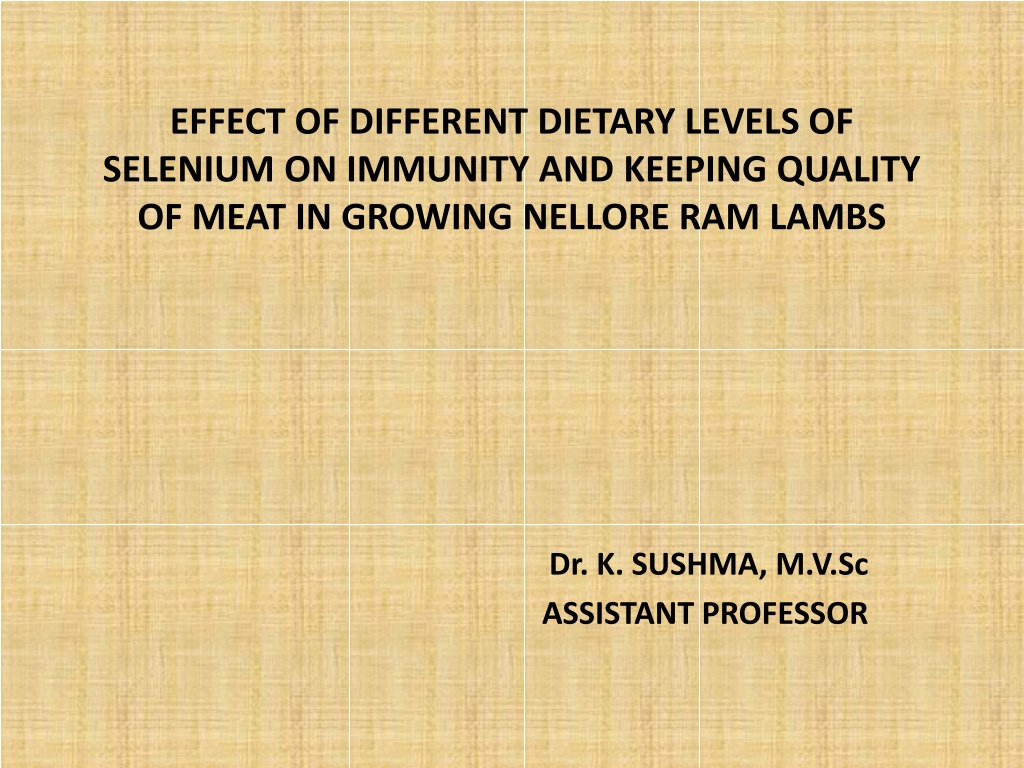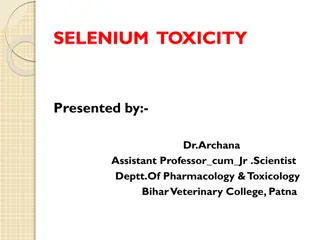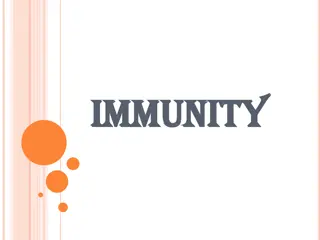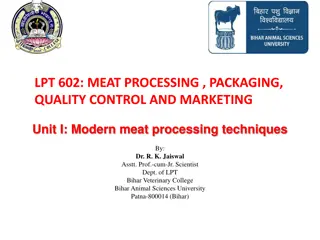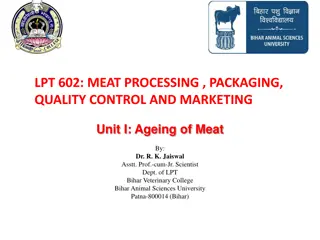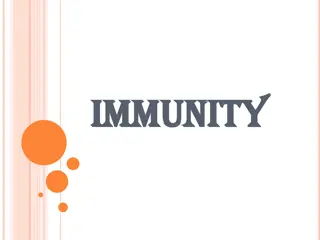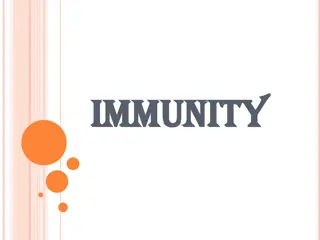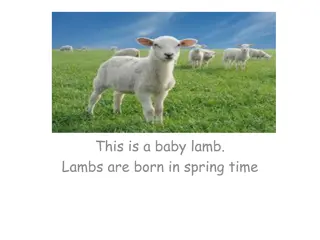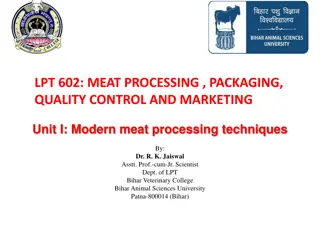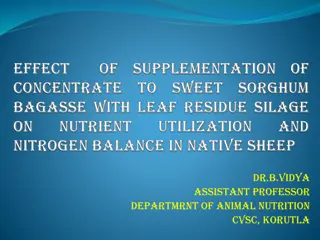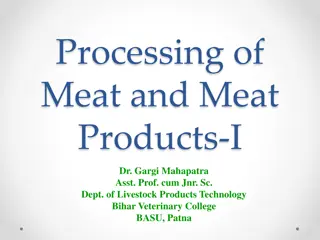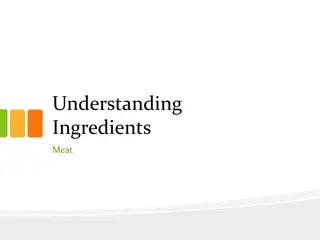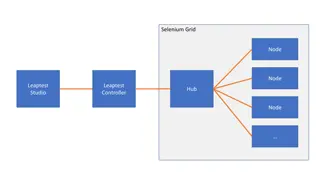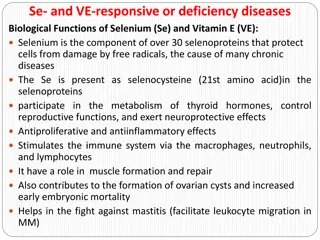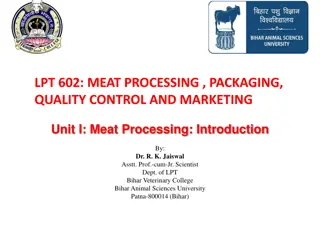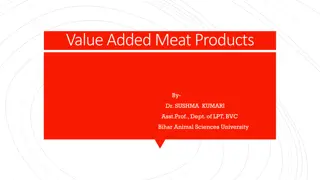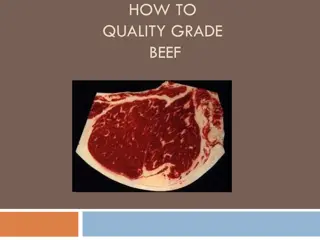Effect of Selenium Levels on Immunity and Meat Quality in Nellore Ram Lambs
Sheep and goats play a vital role in the economy of India, contributing significantly to meat production. The study explores the impact of different dietary selenium levels on immunity and meat quality in Nellore Ram lambs. Selenium plays a crucial role in animal health, particularly in enhancing disease resistance and flock viability. Nutritional factors like energy, protein, vitamins, and minerals are essential for optimal growth and immunity in sheep. Recommendations for selenium supplementation in sheep diets have evolved over the years, suggesting higher selenium requirements than previously thought. Understanding selenium's role, especially through selenoproteins with antioxidant functions, contributes to improving overall sheep health and productivity.
Download Presentation

Please find below an Image/Link to download the presentation.
The content on the website is provided AS IS for your information and personal use only. It may not be sold, licensed, or shared on other websites without obtaining consent from the author. Download presentation by click this link. If you encounter any issues during the download, it is possible that the publisher has removed the file from their server.
E N D
Presentation Transcript
EFFECT OF DIFFERENT DIETARY LEVELS OF SELENIUM ON IMMUNITY AND KEEPING QUALITY OF MEAT IN GROWING NELLORE RAM LAMBS Dr. K. SUSHMA, M.V.Sc ASSISTANT PROFESSOR
INTRODUCTION Sheep and goat are the species of economic value to the small and marginal farmers and landless labour in India. Sheep and goats with its multi-facet utility for meat, milk, wool, skins and manure form an important component of rural economy particularly in the arid and semi-arid areas of the India.
India is having 74 millions of sheep and 154 millions of goats and these animals produce 26.98 x104 MT mutton and 66.63 x 104 MT chevon per year (FAO, 2010). Contribution of sheep and goat sector to the Indian economy is estimated to Rs. 2, 900cr. per annum. Their contribution to the economy is quite substantial and constitutes about 5.40 per cent of Gross National Product (GNP) of agriculture sector.
In addition to nutritional insufficiency, the sheep is more prone to various diseases like parasitic infestation, viral infections like Peste des petits (PPR), blue tongue and several respiratory infections. Thus the major goal of sheep rearers for obtaining maximum profits is to minimize the losses from disease and attain good flock viability, which could be obtained by improving the disease resistance capacity of the flock.
Nutrition is the major decisive factor, which determines the expression of genetic potential of animal in terms of growth and immunity (Klasing and Barnes, 1988). The nutrients recognized as having an important role in immunity are energy, protein, vitamins (A, E, C, B6, B12, folic acid and choline) and minerals (Cu, Se, Zn, Co, Mn and Fe).
Earlier, National Research Council (NRC 1985) recommended a dietary level of 0.1 to 0.2 ppm of Se for sheep, but in its later report, supplementation of 0.3 ppm of Se has been recommended in the diet of cattle, sheep, and pigs (NRC 2001). Salt Institute (2005) has recommended 30 ppm selenium to be added in the salt mineral mixture for sheep as compared to 20 ppm for cattle, indicating that Se requirements of sheep might be higher than cattle.
Seleniums role in animal health is based on the functions of selenoproteins, many of which have antioxidant activities (Fairweather-Tait et al., 2010). Selenium enhances the ability of lymphocytes to respond to the cytokine IL-2 by increasing the expression of IL-2 receptors on lymphocytes. Enhancement of these interactions leads to increased numbers of lymphocytes, increased cytotoxicity of killer cells, and increased antibody production by B cells (Rooke et al., 2004).
The goal of enhancing immunity is to increase resistance to disease. A decreased incidence of metritis in Se-treated dairy cows provides a good example of an association between Se deficiency and decreased disease resistance (Suttle and Jones, 1989). It has been observed in cattle herds, with long-standing annual problems with foot rot and pink eye, that there is a markedly reduced incidence (seasonal) of these diseases once exposed to continuous Se supplementation (Koller et al., 1983). Hence, in this study an attempt has been made to determine the possible strategic role of selenium at different levels of supplementation.
MATERIALS AND METHODS Experimental Animals Twenty four Nellore ram lambs (3-5 months old) with an average body weight of 15.45 + 0.06 kg were purchased from local market and used for the study. These lambs were then randomly allotted to 4 groups (6 in each treatment) in a completely randomized design. The animals of group T1 (basal) were offered basal diet, group T2, T3 and group T4 were offered basal diet supplemented with selenium at 0.45, 0.9 and 1.8 ppm, respectively by adding inorganic selenium in the form of sodium selenite.
The four diets (T1, T2, T3 and T4) were randomly assigned to four groups of animals in a 120 d growth trial. Concentrate mixture @ 1 per cent body weight was offered along with the ad libitum of green roughage as APBN 1 and dry roughage as sorghum daily in the morning at 8 AM. Residues, if any were weighed on the next morning. Thus, the exact quantity of feed consumed daily by the experimental animals was recorded throughout the experimental period.
IMMUNOLOGICAL STUDY Humoral Immunity To assess the humoral immune response in the experimental animals the antibody titres in the blood were measured. For this blood collection and vaccination of the animals has been done. For the development of antibodies the enterotoxaemia vaccine of batch no.06 which was manufactured by M/S Veterinary Biological Research Institute, Hyderabad was given. The vaccine was given subcutaneously 1ml as the dose per animal. The booster dose of the vaccine was given on the 14th day.
Then about 10 ml of blood was collected from the jugular vein for collection of serum from each lamb on the 0th day and also post vaccination of 14, 21and 28 days. All these samples were preserved at -20 C. All the samples were then analysed for antibody titres by using the procedure of an indirect ELISA.
Cell Mediated Immunity To estimate the cell mediated immunity sheep pox vaccine, which is the live attenuated lamb testicular cell culture freeze dried vaccine, was given to the animals(as PHA-P is the non specific mitogen). This belongs to VBRI, Shantinagar, Hyd-28. Phytohaemagglunin Phosphate (PHA-P) was used as a non-specific mitogen to evaluate cellular immunity. An area of approximately 6 6 cm was clipped on both sides of the neck of the sheep and approximately 2 2 cm was delineated with an indelible marker. The initial skin-fold thickness at each site was measured using vernier callipers. Sheep were intradermally inoculated on one side of the neck with 100 l of PHA-P diluted to 1 mg/ml in distilled water. Distilled water (100 l) was injected into the opposite side of the neck to serve as a negative control. Skin fold thickness was measured again 24h after injection.
TBA Procedure To estimate the quality of meat TBARS procedure is established. In this 4 g of meat sample is taken in a test tube and then 20 ml of TCA (Tri chloro acetic acid) was added to it. Then it was homogenized and filtered through the filter paper. Then 3 ml of it was taken in another test tube. Then added 2 ml of TBA to it. Then covered with aluminium foil and vortexed the tube, kept in hot water bath for 30 min. Again vortexed the tube again. Then the readings were taken in UV Spectrophotometer at 340 nm.
Effect of supplementation of different levels of selenium on humoral immune response against Enterotoxaemia titers assayed by ELISA in growing Nellore Ram lambs(% positivity values). Diet Day T1 T2 T3 T4 SEM 0th d 9.25 0.79 12.43 1.27 7.56 2.27 11.56 2.49 0.95 14th d 51.43 4.04 48.55 3.63 54.77 10.08 62.23 5.08 3.11 21st d 54.71 4.32b 59.85 6.38b 66.93 9.85b 95.96 5.58a 4.61 28th d 54.09 5.17b 59.98 5.73b 68.54 10.07b 99.07 6.76a 4.93 Each value is the average of six observations a, bvalues bearing different superscripts in a row differ significantly (P<0.05)
Effect of supplementation of different levels of selenium on humoral immune response against enterotoxaemia titers assayed by ELISA in growing Nellore ram lambs 120 100 80 ELISA titers (%) T1 60 T2 T3 40 T4 20 0 0 14 21 28 day of post sensitization
DISCUSSION HUMORAL IMMUNE RESPONSE The supplementation of selenium has shown the effect on immune response and the per cent positivity values were significantly different on 21st and 28th day of post sensitization and on those 2 days the response was increased linearly Neutrophils and macrophages kill bacteria by generating superoxide and hydrogen peroxide in the respiratory burst process (Rooke et al., 2004; Tizard, 2009). Selenium deficiency impairs the ability of certain GHPx enzymes ability to metabolize peroxides and prevent self-inflicted damage (Arthur, 2003).
Kumar et al. (2008) reported that the serum antibody response against P. multocida P52 antigen in the lambs as measured by absorbance at 492 nm in ELISA on different days of collection in different groups has been observed that antibody mediated immune response was significantly (P<0.01) higher in both the selenium- supplemented groups as compared to control group, but there was no significant (P>0.05) difference between the two Se supplemented groups.
Effect of supplementation of different levels of selenium on the cell mediated immune response (CMI) in growing Nellore ram lambs in terms of skin fold thickness by injecting PHA-P antigen Skin Diet Thickness SEM T1 T2 T3 T4 Initial test 4.07 0.26 3.48 0.24 3.93 0.44 3.13 0.26 0.16 Final test 8.63 0.43b 9.47 0.70ab 10.04 0.72ab 12.07 0.78a 0.51
Effect of supplementation of different levels of selenium on the cell mediated immune response (CMI) in growing Nellore ram lambs in terms of skin fold thickness by injecting PHA-P antigen Increase in skinfold thickness (mm) 14 12 10 8 T1 T2 6 T3 T4 4 2 0 0 h 24 h Hours of post sensitization
Cell Mediated Immunity The assay was directly proportional to increase in the skin fold thickness of the animal after challenge. After inoculation of PHA- P the skin fold thickness increased and it was highest in T4 group. The increased Cell-mediated immune response may be due to the reason that interactions between antigens and immune cells. Signaling molecules such as cytokines bind to target receptors on other immune cells (Tizard, 2009). Selenium enhances the ability of lymphocytes to respond to the cytokine IL-2 by increasing the expression of IL-2 receptors on lymphocytes (Rooke et al., 2004).
Enhancement of these interactions leads to increased numbers of lymphocytes, increased cytotoxicity of killer cells, and increased antibody production by B cells (Rooke et al., 2004; Tizard, 2009). During week 4, the response to intradermally injected phytohaemagglutinin, an index of the in vivo cell-mediated immune response, was shown to be increased in the groups fed on the Se-supplemented diets of Japanese quail chicks of 0-6 week (Biswas et al., 2006).
Effect of supplementation of different levels of selenium on keeping quality of meat measured in terms of TBARS (mg melanaldehyde/kg meat) in growing Nellore ram lambs. Diet Day SEM T1 T2 T3 T4 0th d 0.20 0.01 0.18 0.01 0.19 0.02 0.19 0.01 0.01 3rd d 0.32 0.01 0.32 0.02 0.32 0.02 0.31 0.02 0.01 6th d 0.61 0.03 0.58 0.04 0.55 0.01 0.55 0.05 0.02
Effect of supplementation of different levels of selenium on keeping quality of meat measured in terms of TBARS (mg melanaldehyde/kg meat) in growing Nellore ram lambs 0.7 0.6 melanaldehyde mg/kg meat 0.5 0.4 T1 T2 0.3 T3 T4 0.2 0.1 0 0 3 6 Day of Postslaughter
MEAT QUALITY Supplementation of selenium at different levels did not influence the keeping quality of meat. Vignola et al. (2009) reported that selenium supplementation in either forms organic and inorganic sources did not show significant differences between the treatments in the meat quality assessed by oxidative stability of meat. Skrivanova et al. (2007) found that dietary Se had no effect on the fatty acid profile of the Longissimus thoracis muscle in calves that had received diets containing either basal Se or Se-enriched yeast. O Gradyet al. (2001) suggested that dietary Se has limited potential for increasing the oxidative stability of meat. Taylor (2008) reported that beef steaks from cattle supplemented with Se had similar shelf life attributes to those from unsupplemented animals despite having greater Se contents. These results were in agreement with Juniper et al. (2009).
